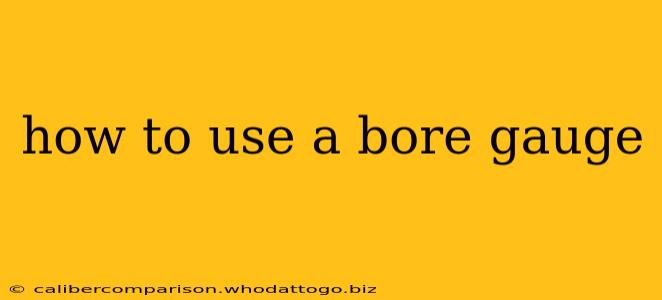Bore gauges are precision instruments used to accurately measure the internal diameter of cylindrical parts, such as holes, cylinders, and bushings. Understanding how to properly use a bore gauge is crucial for ensuring accurate measurements and maintaining the integrity of your work. This guide provides a step-by-step process, highlighting best practices and troubleshooting common issues.
Understanding Bore Gauge Types
Before delving into the usage, let's briefly discuss the different types of bore gauges available:
- Mechanical Bore Gauges: These gauges utilize mechanical components to measure the bore diameter. They are typically less expensive than electronic options but may require more skill and experience to use accurately.
- Electronic Bore Gauges: These gauges employ electronic sensors to provide highly accurate digital readings. They are often preferred for their ease of use and precision, though they tend to be more costly.
- Dial Bore Gauges: These feature a dial indicator for precise measurement readings. The dial indicator shows the deviation from a pre-set value.
This guide will cover the general principles applicable to most bore gauges, but specific operating instructions may vary depending on the manufacturer and model. Always refer to your specific gauge's manual for detailed instructions.
Step-by-Step Guide to Using a Bore Gauge
1. Preparation is Key:
- Clean the workpiece and gauge: Ensure both the internal surface of the part you're measuring and the bore gauge itself are thoroughly clean and free of debris. Even tiny particles can significantly affect the accuracy of your measurements. Use a clean, lint-free cloth and appropriate cleaning solvent if necessary.
- Choose the right gauge: Select a bore gauge with a range that appropriately covers the expected diameter of the hole. Using a gauge outside its specified range will lead to inaccurate readings.
- Check for proper zero setting: Before taking measurements, verify that your bore gauge is correctly zeroed. The method for zeroing varies depending on the type of gauge; consult your instruction manual.
2. Inserting the Gauge:
- Gentle insertion: Carefully insert the gauge's measuring probes into the bore. Avoid applying excessive force, which can damage both the gauge and the workpiece. The probes should smoothly and evenly contact the bore's walls.
- Even contact: Ensure that all measuring points of the gauge are in contact with the bore's surface. Uneven contact will result in inaccurate readings.
- Proper orientation: Be mindful of the orientation of the gauge within the bore. For some gauges, alignment is crucial for accurate measurements.
3. Reading the Measurement:
- Observe the indicator: Carefully read the measurement displayed on the gauge's indicator (dial or digital display). Note the units of measurement (usually inches or millimeters).
- Multiple readings: Take multiple readings at different locations within the bore. This helps to account for any variations in the bore's diameter. Average the readings for a more accurate overall measurement.
- Record your measurements: Keep a detailed record of your measurements, including the date, time, workpiece identification, and any relevant environmental conditions.
4. Gauge Maintenance:
- Regular cleaning: Clean your bore gauge after each use to prevent dirt and debris from affecting future measurements.
- Proper storage: Store the bore gauge in a clean, dry, and safe location to protect it from damage and corrosion.
- Calibration: Periodic calibration is essential to ensure the accuracy of your bore gauge. The frequency of calibration depends on the gauge's specifications and usage.
Troubleshooting Common Issues:
- Inconsistent readings: This could indicate a dirty gauge, uneven contact with the bore, or a damaged gauge. Clean the gauge, ensure even contact, and consider recalibration.
- Gauge malfunction: If you suspect a gauge malfunction, immediately cease use and contact the manufacturer or a qualified service technician.
Conclusion:
Using a bore gauge accurately requires patience, precision, and careful attention to detail. By following these steps and understanding the principles outlined above, you can ensure reliable and consistent measurements, contributing to improved quality control and manufacturing processes. Remember to always consult your gauge's specific instruction manual for detailed guidance and safety precautions.

